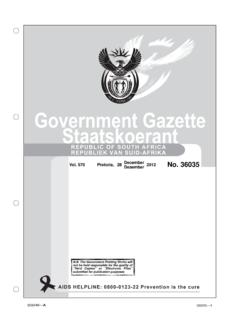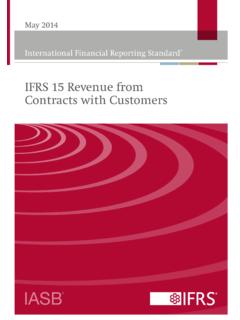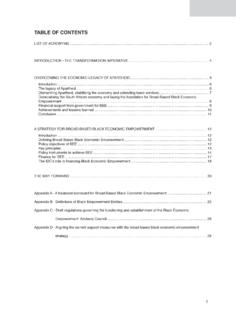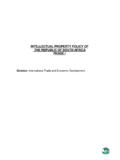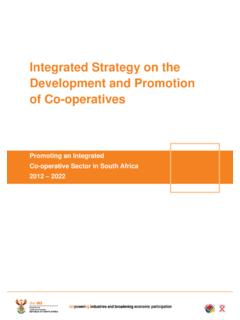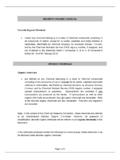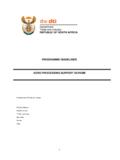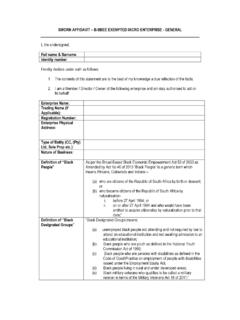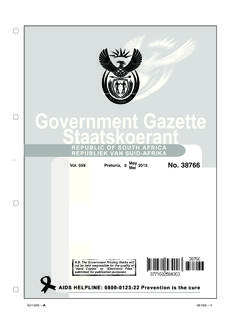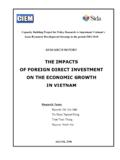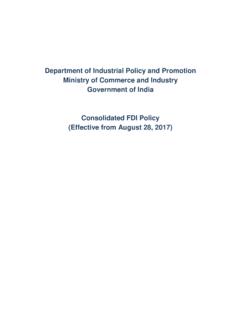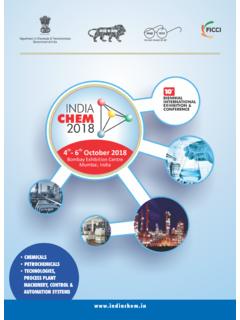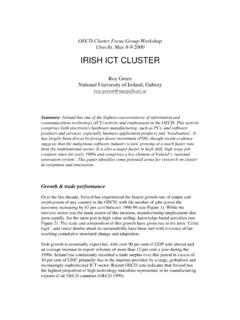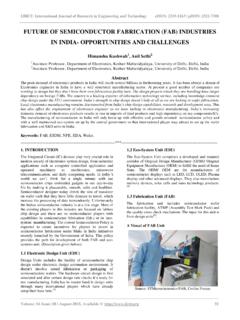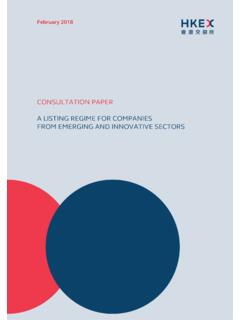Transcription of A Guide to Incentive Schemes 2014/15
1 A Guide to Incentive Schemes 2014 /15. towards full-scale industrialisation and inclusive growth Department of Trade and Industry, September 2014 . Photos are royalty-free stock images, courtesy of , and Media Club South Africa, the dti Campus 77 Meintjies Street Sunnyside Pretoria 0002. the dti Private Bag X84. Pretoria 0001. the dti Customer Contact Centre: 0861 843 384. the dti Website: Important Note: All Incentive Schemes on offer by the Department of Trade and Industry (the dti) have their own specific guidelines and qualifying criteria. Please consult these before making any enquiries or decisions. Guidelines, application forms and further information about the dti's many Incentive offerings are available via the dti website ( ) and can also be obtained from the various administrative offices at the dti Campus.
2 A Guide to Incentive Schemes 2014 /15. Contents Section 1: Industrial Development Automotive investment Scheme (AIS)..4. Capital Projects Feasibility Programme (CPFP)..6. Clothing and Textile Competitiveness Improvement Programme (CTCIP)..8. Production Incentive (PI)..9. Critical Infrastructure Programme (CIP)..10. Manufacturing Competitiveness Enhancement Programme (MCEP). People-Carrier Automotive Incentive Scheme (P-AIS)..17. Section 12I Tax Allowance Incentive (12I)..20. Support Programme for Industrial Innovation (SPII)..22. Aquaculture Development Enhancement Programme (ADEP)..23. Section 2: Broadening Participation Black Business Supplier Development Programme (BBSDP)..26. Co-operative Incentive Scheme (CIS)..27. Technology and Human Resources for Industry Programme (THRIP).
3 30. Incubation Support Programme (ISP)..30. Section 3: Trade, Export and investment Business Process Services (BPS)..35. Export Marketing and investment Assistance (EMIA) ..37. Film and Television Foreign Film and Television Production and Post-Production South African Film and Television Production and Co-Production South African Film and Television Production and Co-Production Incentive The South African Emerging Black Filmmakers Sector-Specific Assistance Scheme (SSAS)..48. Vision A dynamic industrial, globally competitive South African economy, characterised by inclusive growth and development, decent employment and equity, built on the full potential of all citizens.. Mission Introduction the dti's mission is to: Promote structural transformation, towards a dynamic industrial and globally competitive economy.
4 Provide a predictable, competitive, equitable and socially responsible environment, conducive to investment , trade and enterprise development;. Broaden participation in the economy to strengthen economic development; and Continually improve the skills and capabilities of the dti to effectively deliver on its mandate and respond to the needs of South Africa's economic citizens. A Guide to Incentive Schemes 2014 /15. Strategic Objectives Facilitate transformation of the economy to promote industrial development, investment , competitiveness and employment creation. Build mutually bene cial regional and global relations to advance South Africa's trade, industrial policy and economic development objectives. Facilitate broad-based economic participation through targeted interventions to achieve more inclusive growth.
5 Create a fair regulatory environment that enables investment , trade and enterprise development in an equitable and socially responsible manner. Promote a professional, ethical, dynamic, competitive and customer-focused working environment that ensures effective and efficient service delivery. Financial Assistance ( incentives ). To increase industrial competitiveness and broaden the participation of enterprises in the economy, the dti provides financial support to qualifying companies in various sectors of the economy. Financial support is offered for various economic activities, including manufacturing, business competitiveness, export development and market access, as well as foreign direct investment . 3. Automotive investment Scheme (AIS). The AIS is designed to grow and develop the automotive sector through investment in new and/or replacement models and components that will increase plant production volumes, sustain employment and/or strengthen the automotive value chain.
6 Section 1: Industrial Eligible Enterprises Development incentives Light motor vehicle manufacturers that have achieved, or can demonstrate that they will achieve, a minimum of 50 000 annual units of production per plant within a period of three years; or Component or deemed component manufacturers that are part of the Original Equipment Manufacturer (OEM) supply chain and will achieve at least 25% of a total entity turnover or R10 million by the end of the first full year of commercial production as part of a light motor vehicle manufacturer supply chain, locally and/or internationally. A Guide to Incentive Schemes 2014 /15. Objectives Strengthen and diversify the sector through investment in new and/or replacement models and components. Increase plant production volumes.
7 Sustain employment and/or strengthen the automotive value chain. Benefits The AIS provides for a non-taxable cash grant of 25% of the value of qualifying investment in productive assets, as approved by the dti. An additional non-taxable cash grant of 5% to 10% may be made available for projects that significantly contribute to the development of the automotive sector. 55. Capital Projects Feasibility Programme (CPFP). The CPFP is a cost-sharing programme that contributes to the cost of feasibility studies likely to lead to projects outside South Africa that will increase local exports and stimulate the market for South African capital goods and services. Objectives Facilitate feasibility studies that will lead to high-impact projects, which will stimulate value- adding economic activities in South Africa.
8 Attract high levels of foreign investment . Strengthen international competitiveness of South African capital goods sector and allied industries. Create sustainable jobs. Create a long-term demand for South African capital goods and services. Stimulate project development in Africa and, in particular, the Southern African Development Community (SADC) countries as well as support for the objectives of the New Partnership for Africa's Development (NEPAD). Stimulate upstream and downstream linkages with SMMEs and BEE companies. A Guide to Incentive Schemes 2014 /15. Eligible Enterprises the dti will determine whether the feasibility study is eligible by taking the following into account: Feasibility studies must be undertaken by a South African-registered legal entity in terms of the Companies Act, 1973 (as amended); or the Companies Act, 2008; the Close Corporations Act, 1984 (as amended); or the Co-operatives Act, 2005 (as amended).
9 If a feasibility study is undertaken by a foreign entity, the application will only be considered if that entity partners with a South African-registered company and the application is submitted by the South African entity. Benefits The programme's contribution is in the form of a grant of up to 50% of the feasibility study costs for projects outside Africa and 55% for projects in Africa. The grant for the feasibility study is capped at a maximum of R8 million (VAT exclusive). 7. Clothing and Textile Competitiveness Improvement Programme (CTCIP). The CTCIP aims to build capacity among clothing and textile manufacturers and in other areas of the apparel value chain in South Africa to enable them to effectively supply their customers and compete on a global scale.
10 Such competitiveness encompasses issues of cost, quality, flexibility, reliability, adaptability and the capability to innovate. Objectives The main objective of the CTCIP is to create a group of globally competitive clothing and textile companies, thus ensuring a sustainable environment that will retain and grow employment levels. A Guide to Incentive Schemes 2014 /15. Production Incentive (PI). Under the PI, applicants can use the full benefit as either an upgrade grant facility or an interest subsidy facility, or a combination of both. Objectives Assist the industry in upgrading its processes, products and people. Eligible Enterprises Clothing manufacturers Textile manufacturers Cut, Make and Trim (CMT) operators Footwear manufacturers Leather goods manufacturers Leather processors (specifically for leather goods and footwear industries).
